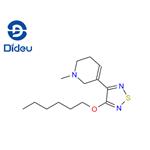Xanomeline manufacturers
- Xanomeline
-

- $50.00 / 5mg
-
2025-06-11
- CAS:131986-45-3
- Min. Order:
- Purity: 99.61%
- Supply Ability: 10g
- Xanomeline
-

- $0.00 / 5KG
-
2025-06-09
- CAS:131986-45-3
- Min. Order: 1KG
- Purity: 98%
- Supply Ability: 5000KGS
- Xanomeline
-

- $0.00 / 10mg
-
2025-03-04
- CAS:131986-45-3
- Min. Order: 10mg
- Purity: 0.98
- Supply Ability: 5g
|
| | Xanomeline Basic information |
| Product Name: | Xanomeline | | Synonyms: | 3-[4-(Hexy loxy)-1,2�����,5-thiadiazol-3-y1]-1���,2�����,5���,6-tetrahydro-1-methylpyridine;5-(4-HEXYLOXY-[1,2,5]THIADIAZOL-3-YL)-1-METHYL-1,2,3,6-TETRAHYDRO-PYRIDINE;Lomeron;LY-246708;Memcor;NNC-11-0232;3-(Hexyloxy)-4-(1-methyl-1,2,5,6-tetrahydropyridin-3-yl)-1,2,5-thiadiazole;Xanomeline L-tartrate hydrate | | CAS: | 131986-45-3 | | MF: | C14H23N3OS | | MW: | 281.42 | | EINECS: | | | Product Categories: | API | | Mol File: | 131986-45-3.mol |  |
| | Xanomeline Chemical Properties |
| Boiling point | 397.0±42.0 °C(Predicted) | | density | 1.101±0.06 g/cm3(Predicted) | | storage temp. | Sealed in dry,2-8°C | | solubility | H2O: soluble10mg/mL, clear (warmed) | | form | powder | | pka | 7.34±0.40(Predicted) | | color | off-white | | InChIKey | JOLJIIDDOBNFHW-UHFFFAOYSA-N |
| | Xanomeline Usage And Synthesis |
| Description | Xanomeline is used as a potent and selective muscarinic type 1 and type 4 (M1/M4) receptor agonist to increase neuronal excitability. Xanomeline is used in studies of neurological disorders such as Alzheimer's disease and schizophrenia. However, development of the drug was halted due to severe cholinergic adverse effects. Currently, xanomeline-trospium (KarXT) (a peripheral cholinergic antagonist) has been explored for the treatment of schizophrenia and a New Drug Application has been filed with the FDA, with a decision on whether it will be approved or not expected on 26 September 2024. | | Uses | Alzheimer’s disease treatment (cholinergic agonist). | | Definition | ChEBI: Xanomeline is a member of thiadiazoles and a tetrahydropyridine. It has a role as a muscarinic agonist and a serotonergic agonist. | | Mechanism of action | Xanomeline's mechanism of action is is to rebalance key neurotransmitter circuits, including acetylcholine, dopamine and glutamate, which are disrupted in schizophrenia and related disorders. | | in vivo | Xanomeline (0.5~3 mg/kg; s.c.; 1~3 hours) induces salivation and vomiting in some monkeys[3].
Xanomeline shows functional dopamine antagonism and an antipsychotic-like profile.
Xanomeline inhibits D-amphetamine- and ( )-apomorphine-induced behavior and do not cause extrapyramidal side effects[3]. | Animal Model: | Male Cebus apella monkeys | | Dosage: | 0.5~3 mg/kg | | Administration: | S.c.; 1~3 hours | | Result: | Induced salivation and vomiting in some monkeys.
|
| | IC 50 | mAChR1; mAChR4 |
| | Xanomeline Preparation Products And Raw materials |
|